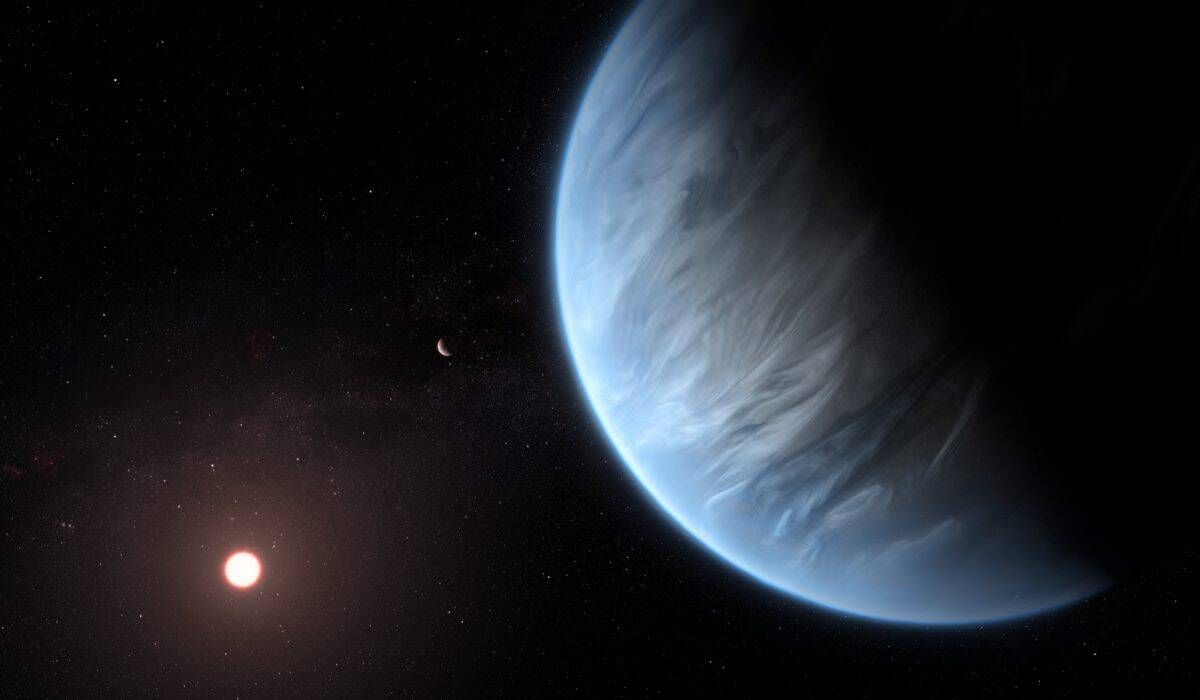
A water world just 110 light years from Earth has been discovered by British astronomers.
It’s the only planet outside our solar system known to have water – and temperatures that could support life.
Named K2-18b, the ‘exoplanet’ is eight times the size of Earth and lies in the constellation of Leo in the northern sky.
Water vapour has been detected in its atmosphere. The greenhouse gas comes from the evaporation of water or ice.
First author Dr. Angelos Tsiaras, of University College London’s Centre for Space Exochemistry Data (CSED), said: “Finding water in a potentially habitable world other than Earth is incredibly exciting.
“K2-18b is not ‘Earth 2.0’ as it is significantly heavier and has a different atmospheric composition.
“However, it brings us closer to answering the fundamental question – is the Earth unique?”
The ‘holy grail’ for today’s planet hunters is to find an Earth-like planet that also has water in its atmosphere
Although water vapour has been found on other far away planets this is the first to be the ideal distance from the solar system’s star to allow life to develop.
The team whose finding is reported in Nature Astronomy say its source could exist in liquid form – a pre-requisite for life.
They combined data from 2016 and 2017 captured by the Hubble Space Telescope and their own algorithms to analyse starlight filtered through the atmosphere.
The results revealed the molecular signature of water vapour – also indicating the presence of hydrogen and helium that produces energy.
Other vitalmolecules including nitrogen and methane may also be present but remain undetectable with current observations.
Further studies are required to estimate cloud coverage and the percentage of atmospheric water present.
The planet orbits a star called K2-18b – a highly active red dwarf. So it is likely to be mpore hostile than Earth – and exposed to more radiation –
K2-18b was discovered in 2015 and is one of hundreds of super-Earths — planets with a mass between Earth and Neptune – found by NASA’s Kepler spacecraft.
NASA’s TESS mission is expected to detect hundreds more super-Earths in the coming years.
Co-author Dr Ingo Waldmann, also of UCL CSED, said: “With so many new super-Earths expected to be found over the next couple of decades, it’s likely this is the first discovery of many potentially habitable planets.
“This is not only because super-Earths like K2-18b are the most common planets in our Galaxy, but also because red dwarfs – stars smaller than our Sun — are the most common stars.”
The next generation of space telescopes, including the NASA/ESA/CSA James Webb Space Telescope and ESA’s ARIEL mission, will be able to characterise atmospheres in more detail as they will carry more advanced instruments.
ARIEL is expected to launch in 2028, and will observe 1,000 planets in detail to get a truly representative picture of what they are like.
Co-author Prof Giovanna Tinetti, also of UCL CSED and principal investigator for ARIEL, said: “Our discovery makes K2-18 b one of the most interesting targets for future study.
“Over 4,000 exoplanets have been detected but we don’t know much about their composition and nature.
“By observing a large sample of planets, we hope to reveal secrets about their chemistry, formation and evolution.”
The team looked for the signal of water absorption in starlight poking through the edges of the atmosphere when the planet passed in front of its star.
Dr Tsiaras added: “This study contributes to our understanding of habitable worlds beyond our solar system and marks a new era in exoplanet research, crucial to ultimately place the Earth, our only home, into the greater picture of the cosmos.”